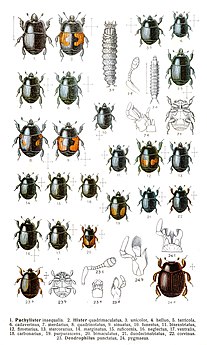Corydoras simulatus is a tropical freshwater fish belonging to the Corydoradinae sub-family of the family Callichthyidae. It originates in inland waters in South America, and is found in the Upper Meta River basin in Colombia.

The Encyclopedia of Life (EOL) is a free, online collaborative encyclopedia intended to document all of the 1.9 million living species known to science. It is compiled from existing databases and from contributions by experts and non-experts throughout the world. It aims to build one "infinitely expandable" page for each species, including video, sound, images, graphics, as well as text. In addition, the Encyclopedia incorporates content from the Biodiversity Heritage Library, which digitizes millions of pages of printed literature from the world's major natural history libraries. The project was initially backed by a US$50 million funding commitment, led by the MacArthur Foundation and the Sloan Foundation, who provided US$20 million and US$5 million, respectively. The additional US$25 million came from five cornerstone institutions—the Field Museum, Harvard University, the Marine Biological Laboratory, the Missouri Botanical Garden, and the Smithsonian Institution. The project was initially led by Jim Edwards and the development team by David Patterson. Today, participating institutions and individual donors continue to support EOL through financial contributions.
Habromys is a genus of rodent in the family Cricetidae, found in Mexico and Central America. It contains these species, all but one (H. lophurus) of which are threatened or endangered, five of them critically so. H. lophurus is near threatened.
The Jico deer mouse is a species of rodent in the family Cricetidae found only in Mexico. Its natural habitat is subtropical or tropical moist lowland forests.
Atelopus simulatus is a species of toad in the family Bufonidae. It is endemic to Colombia. Its natural habitats are subtropical or tropical moist montane forests and rivers. It is threatened by habitat loss.

Saprininae is a subfamily of clown beetles in the family Histeridae. There are more than 50 genera and 800 described species in Saprininae.
Hyperaspidius is a genus of helesius, hyperaspidius, hyperaspis, and thalassa in the family Coccinellidae. There are at least 20 described species in Hyperaspidius.
Euspilotus azurescens is a species of clown beetle in the family Histeridae. It is found in Central America, North America, and South America.
Euspilotus is a genus of clown beetles in the family Histeridae. There are more than 80 described species in Euspilotus.
Euspilotus auctus is a species of clown beetle in the family Histeridae. It is found in Central America and South America.
Euspilotus scissus is a species of clown beetle in the family Histeridae. It is found in North America.
Euspilotus placidus is a species of clown beetle in the family Histeridae. It is found in Central America and North America.
Hyperaspidius simulatus is a species of lady beetle in the family Coccinellidae. It is found in North America.
Euspilotus cribrum is a species of clown beetle in the family Histeridae. It is found in North America.
Euspilotus conformis is a species of clown beetle in the family Histeridae. It is found in North America.
Euspilotus assimilis is a species of clown beetle in the family Histeridae. It is found in North America.
Euspilotus rossi is a species of clown beetle in the family Histeridae. It is found in North America.
Euspilotus scrupularis is a species of clown beetle in the family Histeridae. It is found in Central America and North America.

Historis acheronta, the tailed cecropian, is a species of crescents, checkerspots, anglewings, etc. in the butterfly family Nymphalidae.

Psychoda is a genus of moth flies in the family Psychodidae. There are more than 400 described species in Psychoda.





